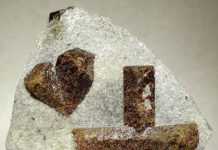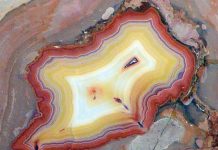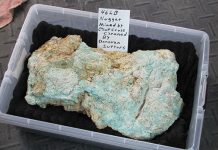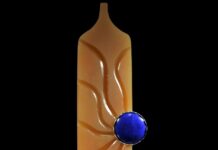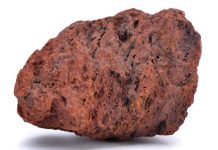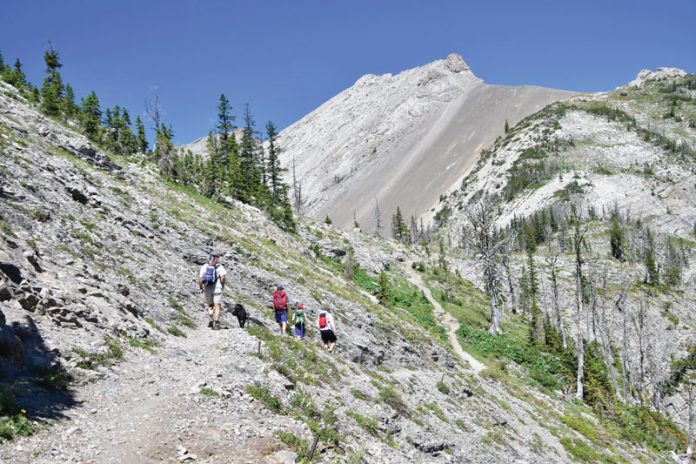
Fossils in the Rocky Mountains can be unexpected since sea creatures don’t typically live at 7000 feet. But that’s exactly what you can find if you look close enough. Here’s why they are there and where to find them.
Spotting the distinct fossil of a horned clam or brachiopod during a nature hike makes trudging uphill worth the effort. And while it’s enjoyable to simply find them, delving into how they formed adds a new layer of delight.
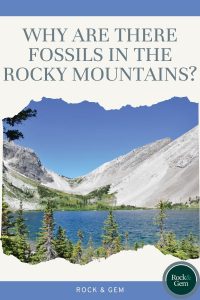
Six years ago, Bill Hansen, a friend and geologist, opened my eyes to why there are fossils in the Rocky Mountains and the geological wonderment of the Rocky Mountain Front in Central Montana as he led my kids on a school field trip. I have since visited the area numerous times. This region, particularly on the plains just beyond the mountains, is well-known in paleontological circles as where Maiasaura peeblesorum, the “good mother lizard,” was discovered by Marion Branvold, owner of the Trex Agate Shop in Bynum, in 1977. After she showed her finds to paleontologist Jack Horner the following year, he and his team discovered multiple nests and specimens, ultimately naming the area “Egg Mountain.” While evidence of dinosaurs and dinosaur bones remains within the Two Medicine Formation stretching onto the plains, the mountains hold older treasures.
Geologic History Behind Rocky Mountain Fossils
It’s difficult to describe Sun Canyon without enthusiastic hand gestures emphasizing its grandeur. During the 20-mile drive to the entrance of Sun Canyon, the vast plains stretch to the east while the magnificent Sawtooth Mountain dominates the western view within the Sun River Wildlife Management Area. The massive walls of Madison limestone standing at the entrance of the canyon were formed by the same process that created the marine fossils in the higher elevations.
Sea creatures in the area, such as trilobites, originated up to 350 million years ago when a shallow tropical ocean covered this entire region, and are ultimately why there are fossils in the Rocky Mountains.
“The big walls were big slabs of limestone on this shallow ocean floor,” says Rob Thomas, regents professor of geology at the University of Montana Western and co-author of Roadside Geology of Montana, considered the go-to tome of Montana’s stunning geological landscape.
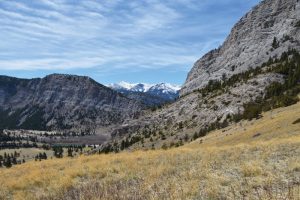
Thomas points out that it was a vastly different world during this time. The North American plate was slightly south of the equator, and Montana was a warm, humid environment.
He notes, “(Montana was) low-lying at the time. It was a time of very high standing sea levels. All the water was in the bucket.” There were also no major ice formations throughout the world. It was the perfect time for growth in the water and land, including enormous insects, such as dragonflies with 10 to 11-foot-long wingspans.
Marine Fossils in the Rocky Mountains: Life in Ancient Seas
Within these warm, clear waters, light reached well within its depths, creating an optimum environment for marine life, including the living versions of the fossils in the Rocky Mountains we find today. Thomas says the horned and tabulate corals, which are both now extinct, “Probably had a relationship with photosynthesizing algae. These made a living in the light zone.” Meanwhile, the clam-like brachiopods filtered the water for organic bits of matter that were abundant in this environment.
How Fossils Formed in the Rocky Mountains
Over the millennia, deposits of sediment and organic matter settled upon other deposits until 100 million years ago when the Farallon Plate collided with the floor of the Pacific Ocean. “It shoved great slabs of rock west to east. Those slabs form the Overthrust Belt. It’s like taking a deck of cards and sliding them across the table. You get older over younger,” Thomas explains.
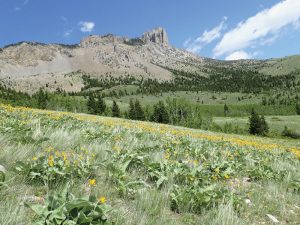
The younger layer, which holds evidence of the dinosaurs found in this region, was shoved underneath the older layers from the ancient ocean floor. As a result, the fossils of marine life once found deep within the ocean were relocated thousands of feet above sea level.
Yet, this wasn’t the end of the region’s transformation. Beginning 50 million years ago, new forces caused the Rocky Mountain front to dome upwards through faults, pulling apart the thinning surface, along with erosion playing a part in exposing the rock.“That’s why we can see what we can see,” says Thomas.
Three Top Rocky Mountain Fossil Sites to Explore
Scouring the lower elevations, which are still roughly 4500 feet above sea level, is a good place to start looking for marine fossils.
1. The Wagner Basin
Bands of coral within the limestone near the pictograph cliffs along the Sun River and clamshells dotting the prairie landscape are wonderful finds.
One of my favorite places for a kids’ hike in Sun Canyon is Wagner Basin.
The beginning of the trail parallels massive limestone walls adorned with faded pictographs from Indigenous peoples. Roughly a half-mile along the trail is the “skull tree” where local artists display wildlife images painted on deer skulls, and a picnic table in the grove in this lovely rest spot, with hats off to whoever packed it back there.
From there, the best direction to go is toward the saddle below the majestic Castle Reef, gaining over 1000 feet in roughly 2.5 miles, topping at 5500 feet. It’s like an Easter egg hunt with a cardio aspect, and looking closely at rocks is a good reason to catch your breath. The hike can pay off with excellent examples of horned coral.
2. Bob Marshall Wilderness
North of Sun Canyon, approximately 23 miles as the raven flies, are more exceptional fossil finds along spectacular hikes. Located within the Bob Marshall Wilderness, Our Lake is a combination of beautiful scenery and an alpine lake known for excellent fishing, all combined with a myriad of fossils. Along the 3.5-mile hike, gaining 1500 feet to the lake that sits at 7300 feet, there’s a prominent limestone section where fossils are frequently spotted within the rocks.
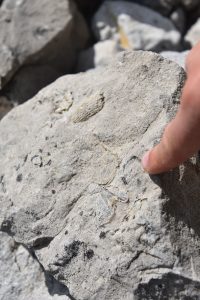
The entire area around the lake is equally good with rock fields surrounding the cirque. Besides fossils, this is the home to marmots and pika, two residents of these alpine areas that make the most of the short summers. The marmots have been particularly bold these past few years, obviously accustomed to frequent hikers, and are quick to lick or chew on sweaty packs and hiking poles. Either secure equipment above their reach, or make ready to chase them down to retrieve hiking poles or other gear.
Far less brazen, pika, the adorable rabbit relative, lives among the rocky slopes.
Visitors almost always hear their “eep!” before spotting a glimpse of them dashing over the boulders. When sitting quietly, it’s easier to figure out their pattern of foraging on nearby forbs and grasses, then running them back to add them to the hay piles beneath the rocks. These caches supply food sources throughout the year as they remain active in their rock dwellings during the long winters.
3. Headquarters Pass
A sister hike to Our Lake, Headquarters Pass originates at the same trailhead and a main gateway to the Bob Marshall Wilderness. Also, 3.5 miles one way, Headquarters adds 300 feet in overall elevation gain, but the views and the rich fossil history are worth it. The hike begins through the forest within view of Rocky Mountain, which at 9392 feet is the highest peak in the Bob Marshall Wilderness, and parallels Headquarters Creek.
Before the final pull through the switchbacks to the pass, there’s a lovely spring that is the perfect place to grab lunch. It’s also a hot spot for fossils, where it’s almost impossible to look at the rocky slope and not find a horned coral or other specimens. This is also the realm of pikas, a bonus during any stop.
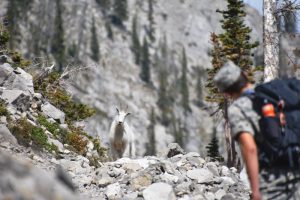
While mountain goats are sometimes seen near Our Lake, there is a fairly consistent group near Headquarters Pass. Montana Fish, Wildlife and Parks often surveys this area, and we counted 16 along the upper slopes near the switchbacks to the pass one July, while during another seaso,n a nanny and kid met us on the trail. Even knowing the geological history of the region, it’s always a bit surreal to have marine fossils where we find mountain goats and pika.
The final push through the series of switchbacks along the limestone terrain tops out at the 7,749-feet-high pass. Expect wind at the top. The trail continues west, paralleling Headquarters Creek and leading to any number of geological adventures, particularly considering that the Bob Marshall Wilderness holds the deepest cave in the United States, the Tears of the Turtle Cave at 1659-feet-deep, as well as the Virgil the Turtle’s Greathouse at 1586-feet, which is the third deepest.
Best Practices for Fossil Collecting in the Rockies – Do’s and Don’ts
As with shells along the beach, it’s tempting when you find fossils in the Rocky Mountains to take a few home, but should we? As a general rule, according to the United States Department of Agriculture, “Fossil hunting allows the collection of petrified wood, invertebrate and plant fossils for personal use. Invertebrate fossils, such as clams, do not have an internal skeleton. Collection of vertebrate (has internal skeleton) fossils requires a permit (36 CFR 261.9i).”
This allows hobbyists to bring home fossils of the marine life found along these wonderful hikes, but be sure to check with district offices before collecting to ensure there is no exception.
🦴⏳FAQ: Fossils in the Rocky MountainsQ: Where can I legally collect fossils in the Rocky Mountains?A: Legal fossil collecting is often allowed on BLM land and some state lands with appropriate permits. Always check local regulations and avoid protected areas like national parks. Q: What types of fossils are common in the Rocky Mountains?A: The Rockies are rich in marine fossils like ammonites and brachiopods, as well as dinosaur remains in areas like the Morrison Formation. Q: Can you find dinosaur bones in Colorado or Utah?A: Yes! Both Colorado and Utah are renowned for dinosaur fossil discoveries, especially in sites like Dinosaur National Monument. Q: When is the best time to go fossil hunting in the Rockies?A: Late spring through early fall is best, when weather allows access to remote fossil beds without snow cover. |
Fossils in the Rocky Mountains: Final Thoughts
What began as a simple field trip for the kids turned into an eye-opening revelation of the geological history of the Rocky Mountain Front. The reality is that these marine fossils scratch the surface of the wonders written within these rocks. Discovering more of its fascinating stories remains a lifelong pursuit.
This story about sea creatures at 7000 feet previously appeared in Rock & Gem magazine. Click here to subscribe. Story and photos by Amy Grisak.


